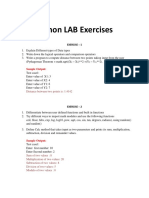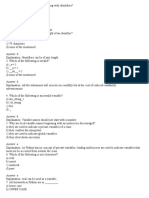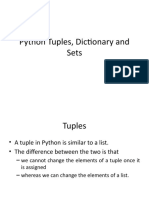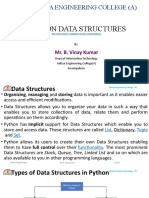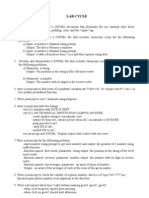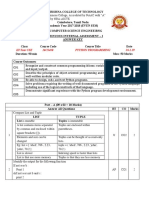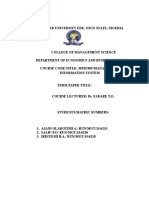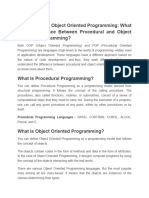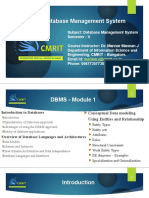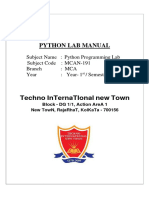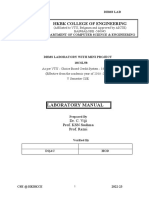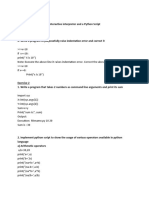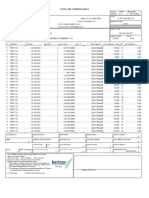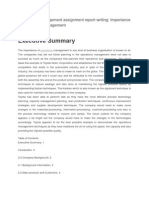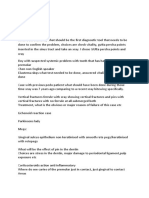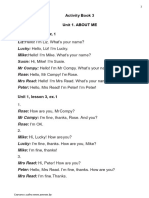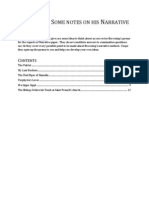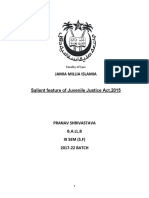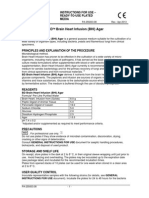Programming Logic and Design Sixth Edition
Chapter 6 Arrays
�Objectives
In this chapter, you will learn about: Arrays and how they occupy computer memory Manipulating an array to replace nested decisions Using constants with arrays Searching an array Using parallel arrays
Programming Logic & Design, Sixth Edition
�Objectives (continued)
Searching an array for a range match Remaining within array bounds Using a for loop to process arrays
Programming Logic & Design, Sixth Edition
�Understanding Arrays and How They Occupy Computer Memory
Array
Series or list of variables in computer memory All variables share the same name Each variable has a different subscript
Subscript (or index)
Position number of an item in an array Subscripts are always a sequence of integers
Programming Logic & Design, Sixth Edition
�How Arrays Occupy Computer Memory
Each item has same name and same data type Element: an item in the array Array elements are contiguous in memory Size of the array: number of elements it will hold
Programming Logic & Design, Sixth Edition
�How Arrays Occupy Computer Memory (continued)
Figure 6-1 Appearance of a three-element array in computer memory
Programming Logic & Design, Sixth Edition
�How Arrays Occupy Computer Memory (continued)
All elements have same group name
Individual elements have unique subscript Subscript indicates distance from first element Subscripts are a sequence of integers
Subscripts placed in parentheses or brackets following group name
Syntax depends on programming language
Programming Logic & Design, Sixth Edition
�Manipulating an Array to Replace Nested Decisions
Example: Human Resources Department Dependents report
List employees who have claimed zero through five dependents
Assume no employee has more than five dependents
Application produces counts for dependent categories
Uses series of decisions
Application does not scale up to more dependents
Programming Logic & Design, Sixth Edition
�Figure 6-3 Flowchart and pseudocode of decision-making process using a series of decisionsthe hard way
Programming Logic & Design, Sixth Edition 9
�Manipulating an Array to Replace Nested Decisions (continued)
Array reduces number of statements needed Six dependent count accumulators redefined as single array Variable as a subscript to the array Array subscript variable must be:
Numeric with no decimal places Initialized to 0 Incremented by 1 each time the logic passes through the loop
Programming Logic & Design, Sixth Edition 10
�Figure 6-4 Flowchart and pseudocode of decision-making processbut still the hard way
Programming Logic & Design, Sixth Edition 11
�Figure 6-5 Flowchart and pseudocode of decision-making process using an arraybut still a hard way
Programming Logic & Design, Sixth Edition 12
�Manipulating an Array to Replace Nested Decisions (continued)
Figure 6-6 Flowchart and pseudocode of efficient decision-making process using an array
Programming Logic & Design, Sixth Edition 13
�Figure 6-7 Flowchart and pseudocode for Dependents Report program
Programming Logic & Design, Sixth Edition 14
�Manipulating an Array to Replace Nested Decisions (continued)
Figure 6-7 Flowchart and pseudocode for Dependents Report program (continued)
Programming Logic & Design, Sixth Edition 15
�Using Constants with Arrays
Use constants in several ways
To hold the size of an array As the array values As a subscript
Programming Logic & Design, Sixth Edition
16
�Using a Constant as the Size of an Array
Avoid magic numbers (unnamed constants) Declare a named numeric constant to be used every time array is accessed Make sure any subscript remains less than the constant value Constant created automatically in many languages
Programming Logic & Design, Sixth Edition
17
�Using Constants as Array Element Values
Sometimes the values stored in arrays should be constants Example
string MONTH[12] = "January", "February", "March", "April", "May", "June", "July", "August", "September", "October, "November", "December"
Programming Logic & Design, Sixth Edition
18
�Using a Constant as an Array Subscript
Use a numeric constant as a subscript to an array Example
Declare a named constant as num INDIANA = 5 Display value with: output salesArray[INDIANA]
Programming Logic & Design, Sixth Edition
19
�Searching an Array
Sometimes must search through an array to find a value Example: mail-order business
Item numbers are three-digit, non-consecutive numbers Customer orders an item, check if item number is valid Create an array that holds valid item numbers Search array for exact match
Programming Logic & Design, Sixth Edition
20
�Figure 6-8 Flowchart and pseudocode for program that verifies item availability
Programming Logic & Design, Sixth Edition 21
�Figure 6-8 Flowchart and pseudocode for program that verifies item availability (continued)
Programming Logic & Design, Sixth Edition 22
�Figure 6-8 Flowchart and pseudocode for program that verifies item availability (continued)
Programming Logic & Design, Sixth Edition 23
�Searching an Array (continued)
Flag: variable that indicates whether an event occurred Technique for searching an array
Set a subscript variable to 0 to start at the first element Initialize a flag variable to false to indicate the desired value has not been found Examine each element in the array If the value matches, set the flag to True If the value does not match, increment the subscript and examine the next array element
Programming Logic & Design, Sixth Edition 24
�Using Parallel Arrays
Example: mail-order business
Two arrays, each with six elements
Valid item numbers Valid item prices
Each price in valid item price array in same position as corresponding item in valid item number array
Parallel arrays
Each element in one array associated with element in same relative position in other array
Look through valid item array for customer item
When match is found, get price from item price array
Programming Logic & Design, Sixth Edition 25
�Figure 6-9 Parallel arrays in memory
Programming Logic & Design, Sixth Edition
26
�Using Parallel Arrays
Use parallel arrays
Two or more arrays contain related data A subscript relates the arrays
Elements at the same position in each array are logically related
Programming Logic & Design, Sixth Edition
27
�Figure 6-10 Flowchart and pseudocode of program that finds an items price using parallel arrays
Programming Logic & Design, Sixth Edition 28
�Figure 6-10 Flowchart and pseudocode of program that finds an items price using parallel arrays (continued)
Programming Logic & Design, Sixth Edition 29
�Figure 6-10 Flowchart and pseudocode of program that finds an items price using parallel arrays (continued)
Programming Logic & Design, Sixth Edition 30
�Improving Search Efficiency
Program should stop searching the array when a match is found Setting a variable to a specific value instead of letting normal processing set it Improves efficiency The larger the array, the better the improvement by doing an early exit
Programming Logic & Design, Sixth Edition
31
�Figure 6-11 Flowchart and pseudocode of the module that finds item price, exiting the loop as soon as it is found
Programming Logic & Design, Sixth Edition 32
�Improving Search Efficiency (continued)
Figure 6-11 Flowchart and pseudocode of the module that finds item price, exiting the loop as soon as it is found (continued)
Programming Logic & Design, Sixth Edition 33
�Searching an Array for a Range Match
Sometimes programmers want to work with ranges of values in arrays Example: mail-order business
Read customer order data; determine discount based on quantity ordered
First approach
Array with as many elements as each possible order quantity Store appropriate discount for each possible order quantity
Programming Logic & Design, Sixth Edition 34
�Searching an Array for a Range Match (continued)
Figure 6-13 Usablebut inefficientdiscount array
Programming Logic & Design, Sixth Edition
35
�Searching an Array for a Range Match (continued)
Drawbacks of first approach
Requires very large array; uses a lot of memory Stores same value repeatedly How do you know you have enough elements?
Customer can always order more
Better approach
Create four discount array elements for each discount rate Parallel array with discount range
Use loop to make comparisons
Programming Logic & Design, Sixth Edition 36
�Searching an Array for a Range Match (continued)
Figure 6-14 Parallel arrays to use for determining discount
Programming Logic & Design, Sixth Edition
37
�Figure 6-15 Program that determines discount rate
Programming Logic & Design, Sixth Edition 38
�Remaining within Array Bounds
Every array has finite size
Number of elements in the array Number of bytes in the array
Arrays composed of elements of same data type Elements of same data type occupy same number of bytes in memory Number of bytes in an array is always a multiple of number of array elements Access data using subscript containing a value that accesses memory occupied by the array
Programming Logic & Design, Sixth Edition 39
�Figure 6-16 Determining the month string from users numeric entry
Programming Logic & Design, Sixth Edition 40
�Remaining within Array Bounds (continued)
Program logic assumes every number entered by the user is valid When invalid subscript is used:
Some languages stop execution and issue an error Other languages access a memory location outside of the array
Invalid array subscript is a logical error Out of bounds: using a subscript that is not within the acceptable range for the array Program should prevent bounds errors
Programming Logic & Design, Sixth Edition 41
�Using a for Loop to Process Arrays
for loop: single statement
Initializes loop control variable Compares it to a limit Alters it
for loop especially convenient when working with arrays
To process every element
Must stay within array bounds Highest usable subscript is one less than array size
Programming Logic & Design, Sixth Edition 42
�Using a for Loop to Process Arrays (continued)
Figure 6-17 Pseudocode that uses a for loop to display an array of department names
Programming Logic & Design, Sixth Edition
43
�Using a for Loop to Process Arrays (continued)
Figure 6-26 Pseudocode that uses a more efficient for loop to output month names
Programming Logic & Design, Sixth Edition
44
�Summary
Array: series or list of variables in memory
Same name and type Different subscript
Use a variable as a subscript to the array to replace multiple nested decisions Some array values determined during program execution
Other arrays have hard-coded values
Programming Logic & Design, Sixth Edition
45
�Summary (continued)
Search an array
Initialize the subscript Test each array element value in a loop Set a flag when a match is found
Parallel arrays: each element in one array is associated with the element in second array
Elements have same relative position
For range comparisons, store either the low- or high-end value of each range
Programming Logic & Design, Sixth Edition
46
�Summary (continued)
Access data in an array
Use subscript containing a value that accesses memory occupied by the array
Subscript is out of bounds if not within defined range of acceptable subscripts for loop is a convenient tool for working with arrays
Process each element of an array from beginning to end
Programming Logic & Design, Sixth Edition
47







